I'm using Intel Advisor to analyze my parallel application. I have this code, which is the main loop of my program and where is spent most of the time:
for(size_t i=0; i<wrapperIndexes.size(); i++){
const int r = wrapperIndexes[i].r;
const int c = wrapperIndexes[i].c;
const float val = localWrappers[wrapperIndexes[i].i].cur.at<float>(wrapperIndexes[i].r,wrapperIndexes[i].c);
if ( (val > positiveThreshold && (isMax(val, localWrappers[wrapperIndexes[i].i].cur, r, c) && isMax(val, localWrappers[wrapperIndexes[i].i].low, r, c) && isMax(val, localWrappers[wrapperIndexes[i].i].high, r, c))) ||
(val < negativeThreshold && (isMin(val, localWrappers[wrapperIndexes[i].i].cur, r, c) && isMin(val, localWrappers[wrapperIndexes[i].i].low, r, c) && isMin(val, localWrappers[wrapperIndexes[i].i].high, r, c))) )
// either positive -> local max. or negative -> local min.
ANNOTATE_ITERATION_TASK(localizeKeypoint);
localizeKeypoint(r, c, localCurSigma[wrapperIndexes[i].i], localPixelDistances[wrapperIndexes[i].i], localWrappers[wrapperIndexes[i].i]);
}
As you can see, localizeKeypoint is where most of the time the loop is spent (if you don't consider the if clause). I want to do a Suitability Report to estimate the gain from parallelizing the loop above. So I've written this:
ANNOTATE_SITE_BEGIN(solve);
for(size_t i=0; i<wrapperIndexes.size(); i++){
const int r = wrapperIndexes[i].r;
const int c = wrapperIndexes[i].c;
const float val = localWrappers[wrapperIndexes[i].i].cur.at<float>(wrapperIndexes[i].r,wrapperIndexes[i].c);
if ( (val > positiveThreshold && (isMax(val, localWrappers[wrapperIndexes[i].i].cur, r, c) && isMax(val, localWrappers[wrapperIndexes[i].i].low, r, c) && isMax(val, localWrappers[wrapperIndexes[i].i].high, r, c))) ||
(val < negativeThreshold && (isMin(val, localWrappers[wrapperIndexes[i].i].cur, r, c) && isMin(val, localWrappers[wrapperIndexes[i].i].low, r, c) && isMin(val, localWrappers[wrapperIndexes[i].i].high, r, c))) )
// either positive -> local max. or negative -> local min.
ANNOTATE_ITERATION_TASK(localizeKeypoint);
localizeKeypoint(r, c, localCurSigma[wrapperIndexes[i].i], localPixelDistances[wrapperIndexes[i].i], localWrappers[wrapperIndexes[i].i]);
}
ANNOTATE_SITE_END();
And the Suitability Report given an excellent 6.69x gain, as you can see here:
However, launching dependencies check, I got this problem message:
In particular see "Missing start task".
In addition, if I place ANNOTATE_ITERATION_TASK at the beggining of the loop, like this:
ANNOTATE_SITE_BEGIN(solve);
for(size_t i=0; i<wrapperIndexes.size(); i++){
ANNOTATE_ITERATION_TASK(localizeKeypoint);
const int r = wrapperIndexes[i].r;
const int c = wrapperIndexes[i].c;
const float val = localWrappers[wrapperIndexes[i].i].cur.at<float>(wrapperIndexes[i].r,wrapperIndexes[i].c);
if ( (val > positiveThreshold && (isMax(val, localWrappers[wrapperIndexes[i].i].cur, r, c) && isMax(val, localWrappers[wrapperIndexes[i].i].low, r, c) && isMax(val, localWrappers[wrapperIndexes[i].i].high, r, c))) ||
(val < negativeThreshold && (isMin(val, localWrappers[wrapperIndexes[i].i].cur, r, c) && isMin(val, localWrappers[wrapperIndexes[i].i].low, r, c) && isMin(val, localWrappers[wrapperIndexes[i].i].high, r, c))) )
// either positive -> local max. or negative -> local min.
localizeKeypoint(r, c, localCurSigma[wrapperIndexes[i].i], localPixelDistances[wrapperIndexes[i].i], localWrappers[wrapperIndexes[i].i]);
}
ANNOTATE_SITE_END();
The gain is horrible:
Am I doing something wrong?
INTEL_OPT=-O3 -simd -xCORE-AVX2 -parallel -qopenmp -fargument-noalias -ansi-alias -no-prec-div -fp-model fast=2
INTEL_PROFILE=-g -qopt-report=5 -Bdynamic -shared-intel -debug inline-debug-info -qopenmp-link dynamic -parallel-source-info=2 -ldl


